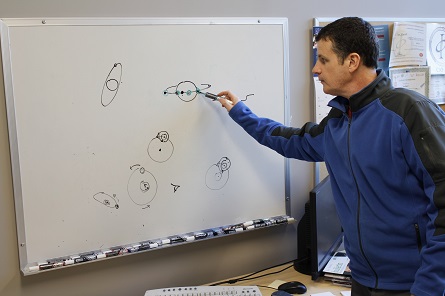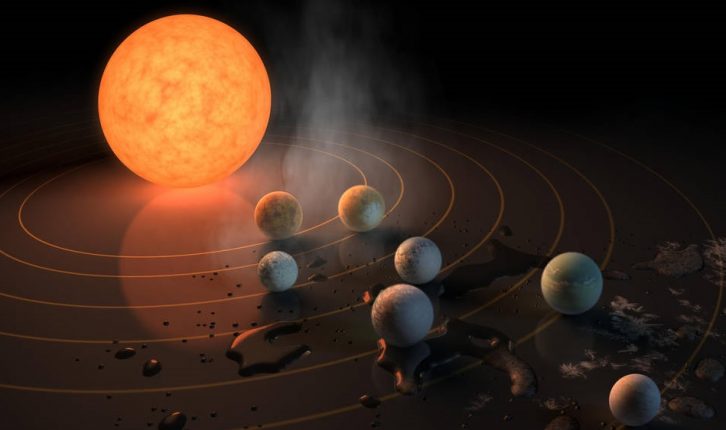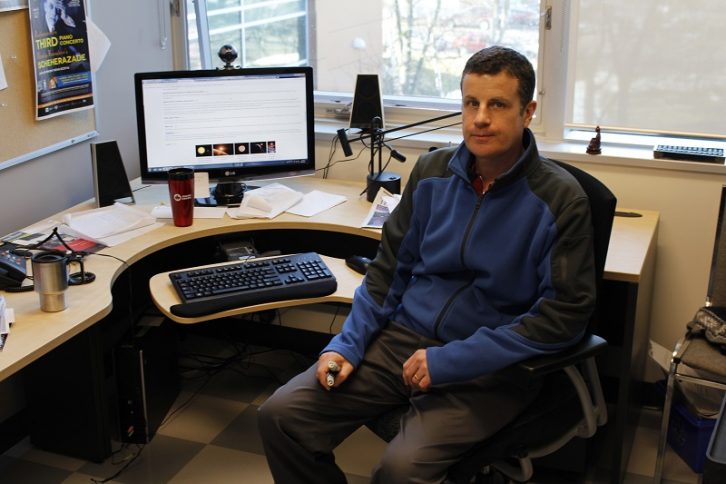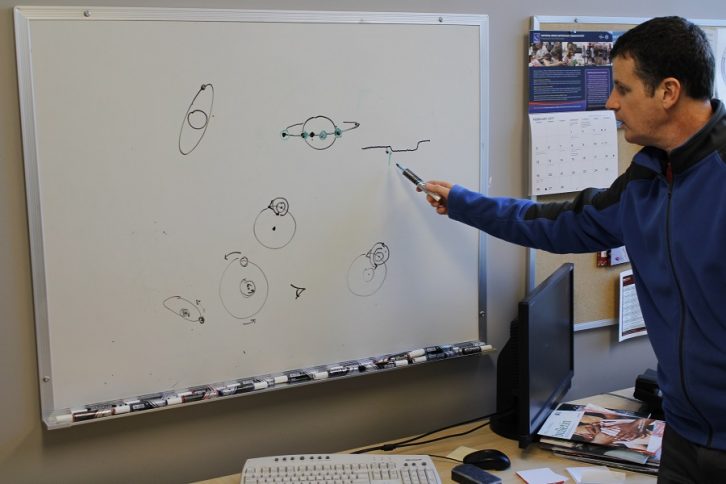Space
NASA’s discovery of new planetary system opens up possibilities
Local stellar astronomer explains why NASA’s discovery is so exciting for the scientific community

caption
Ian Short illustrating the transit discovery method
caption
A concept illustration depicting the newly discovered extrasolar planetary system.Forty light years away from Earth in the constellation Aquarius, NASA has discovered something remarkable.
On Feb. 22, NASA announced their discovery of a system containing seven Earth-size planets orbiting a single star. The planets in this system are orbiting a star known as TRAPPIST-1, and three of these planets are in the star’s habitable zone, meaning they could potentially have liquid water.
Ian Short, an astronomy and physics professor at Saint Mary’s University, is an expert in the study of stars. He said the discovery of this TRAPPIST-1 system is a dream scenario for scientists.

caption
Ian Short specializes in stellar astronomy at Saint Mary’s University.Short said that extrasolar planets were first discovered over twenty years ago. Since then, a lot of them have been closer to the size of gas giants, like Jupiter, and not conducive to life.
For the scientific community, this new discovery is unlike anything seen before.
“I think I can safely say it’s the biggest discovery in terms of extrasolar planet research,” Short said in an interview last Thursday. “No one has found a system of seven Earth-like planets, three in the habitable zone. The reason why NASA had a big special press conference is because that’s just head-and-shoulders above any kind of system anyone has found out there.”
This Week: We found 7 Earth-sized planets orbiting a dwarf star, 3 of them in the habitable zone! Also, @NASA_SLS rocket test & more! Watch: pic.twitter.com/cBBerkelU1
— NASA (@NASA) February 25, 2017
How NASA found it
Short said that NASA discovered this system using the transit photometry method, in which a planet is observed passing in front of its host star.
On top of having planets similar to Earth in size, this system has the rare quality of being perfect for this discovery method and further studies based upon it.
“This system is unusual in that it happens to be lined up just right so that the planets pass right in front of their star,” Short said. “As the planet goes around once every orbit, each planet will pass in front of the star and block a little bit of its light.
“So if you’re following how bright the star is as a function of time, all of a sudden the light drops a little bit, but not much, only by one per cent because it’s a tiny little planet blocking a little bit of its host star.”

caption
Stellar astronomer Ian Short illustrating how NASA determined the size of the extrasolar planets in the TRAPPIST-1 system.By employing this transit method, Short said NASA was able to discover the existence of the planetary system, and also measure the amount of light each planet blocked to determine their size.
Using this data from their Spitzer Space Telescope, NASA measured the density of the planets and found that all of them are likely to be rocky like Earth.
Dream scenario for scientific study
On top of having seven planets similar to Earth, this system is exciting for scientists because of how uncommon it is to find planets passing directly in front of their host star.
“Transiting objects are very rare,” Short said. “It’s like winning the lottery for that orbit to be lined up like that.”
NASA said in its news conference this is just the beginning of what will be years of scientific study on the TRAPPIST-1 system.
Short said having multiple Earth-like planets in perfect alignment for observation becomes even more ripe for study when you consider how frequently they pass by the host star.
Due to the TRAPPIST-1 star being much smaller than Earth’s Sun, the system’s habitable zone is a lot closer to the star. Short explained that, unlike the 365 day orbital period of Earth, these newly discovered planets pass around their host star in a matter of days due to their proximity to the star.
He added that because of this the learning process will be accelerated.
“A short orbital period means you only have to wait a day or so to try again,” he said. “You can get lots of data very quickly.”
Possibility of life?
The ultimate question surrounding the TRAPPIST-1 system is one with major scientific and philosophical implications. Scientists will try to determine if life exists on the three planets in the habitable zone.
The 7 Earth-sized TRAPPIST-1 planets will soon be probed for signs of life with our forthcoming @NASAWebb telescope: https://t.co/jGGlk6Kah2 pic.twitter.com/xxYi0FDaoj
— NASA (@NASA) March 3, 2017
Short said at this point, it is less of a question of if life exists beyond our own world, but when scientists will have the capabilities to locate it.
“That’s certainly what I would hope, and I think a lot of people in this field have this feeling,” Short said. “I think the more planets that turn up around stars that can have a habitable zone like this one, that just makes the odds better and better that if life developed here, then it developed out there somewhere.
“So if I were betting in the long run, I would bet that some kind of life has developed somewhere. Maybe it’s just blue-green algae, because that’s how life was for the first three billion years here.”
Learning at SMU
Astronomy students at SMU are not making new discoveries of their own, but they are able to practice the same method NASA used in this discovery.
While the TRAPPIST-1 star is not bright enough for its system to be seen transiting at SMU’s observatory, Short says some students have used the transit photometry method on other stars.
“Using the telescope here, students have done projects where they have detected transits of brighter stars,” Short said.
Short also said that NASA’s discovery of the TRAPPIST-1 system could lead to some exciting changes in SMU’s astronomy department.
“I think we’re always interested in anything that captures the public’s imagination and the imagination of high school students,” Short said. “What we would probably do first maybe is just change the emphasis of the courses that we have. So if there’s a first-year course we might spend more time on planets, but as more is learned about them there’s more than we can teach. We could eventually introduce a new course that’s just on planets.”
What’s next?
Short said the next step will see the use of more advanced telescopes with higher capabilities to study these Earth-like planets in greater detail.
“The situation is that the telescopes that we have now, like the one that was used to detect this system, those telescopes are good enough to just make the detection and to tell you that something is there,” he said. “The next step is to try to study the atmospheres around these planets, and figure out what they’re made of, like what’s their chemical composition.
“That’s going to require bigger telescopes that can sort of detect the light we get with greater sensitivity, so that we have a stronger signal and we can start to look for information with the light we’re getting. That would tell us whether there’s oxygen on these planets.”
How the future @NASAWebb will study 7 Earth-size planets’ atmospheres for ozone & other signs of life #TRAPPIST1 https://t.co/8JtjzClTga pic.twitter.com/HbZYXUkovS
— Planetquest (@PlanetQuest) March 2, 2017
By studying how the host star’s light changes when shining through each of these planet’s atmospheres, Short said scientists can determine if any of these Earth-like planets have oxygen atmospheres. Finding this type of atmosphere would indicate that there is life regenerating that oxygen.

